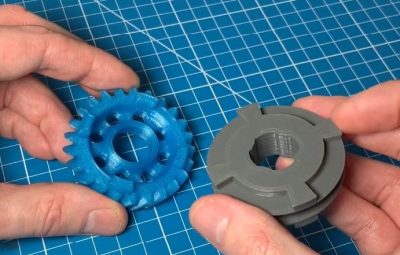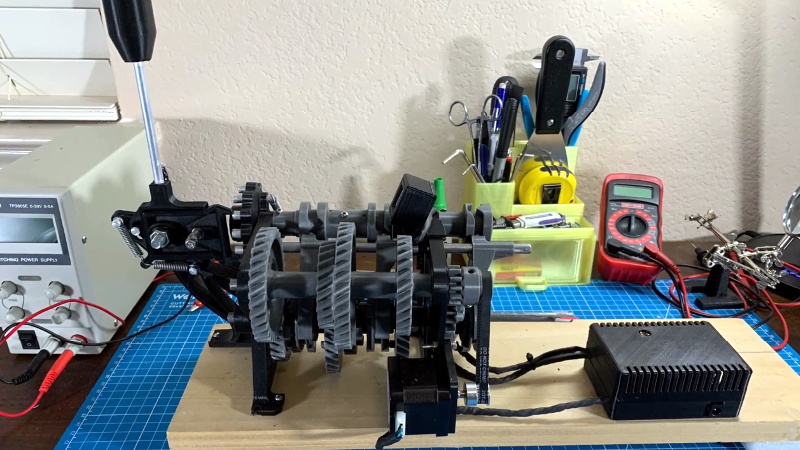It’s often been our experience that some of the most impressive projects are the passion builds, the ones where the builder really put in their all and obsessed over every detail. Even if they don’t always have a practical application, it’s impossible to look at the final product and not respect the accomplishment.
 Case in point, this absolutely incredible 3D printed model of a sequential “dogbox” transmission created by [Indeterminate Design]. All of the STL files and a complete bill of materials are available for anyone brave enough to take on the challenge. It might never be mounted to a vehicle and driven around the track, but you can still flick through the gears and watch the complex gearing do its thing.
Case in point, this absolutely incredible 3D printed model of a sequential “dogbox” transmission created by [Indeterminate Design]. All of the STL files and a complete bill of materials are available for anyone brave enough to take on the challenge. It might never be mounted to a vehicle and driven around the track, but you can still flick through the gears and watch the complex gearing do its thing.
Even if you don’t want to necessarily build the model itself, [Indeterminate Design] takes you through the concepts behind this unique transmission and how it differs from the sort of gearboxes us lowly commuter drivers are familiar with. He’s even nice enough to explain what a dogbox is.
Put simply, this type of transmission allows the driver to simply move the gear change forward and backwards to step through the gears like in a video game. This prevents you from having to navigate an H-pattern gear shift while dealing with all the other stresses of competition driving. Watching it in action, you can certainly see the appeal.
If you prefer your printed gearboxes to be of the practical variety, we’ve certainly seen plenty of those as well. They’re perfect for next time you need to move an anvil around the shop.

















Really cool, however dogbox is not what is described in the article. Gearboxes have different gear engagement methods, almost every passenger vehicle uses synchromeshes which are tiny rings between gears that allows two shafts to reach close enough speeds (which is important for helical gears used in most cars that gears engage each other. Dog engagement happens through teeth on the gears, instead of using clutches so the speak they grab on to each other and instantly equalize speeds. Up and down gear selection is just a shift pattern, meaning gearbox can be a h pattern and have dog engagement. Here is a really good video anyone is interested.
https://youtu.be/7HzX1pXHOMU
That’s also my understanding. dog boxes would be similar to crash gearboxes which aren’t seen much anymore except in 1980s tractors.
And in pretty much any racing applications that use manual/automated gearboxes.
The 3d printed gearbox is a sequential dog-box. Look at the video you linked yourself, there’s two types of engagement, synchromesh and dog engagement. The 3D printed thing certainly doesn’t have synchromesh.
While rare for cars, this is the standard gearbox setup for motorcycles. Usually in a “1 down x-1 up” setup: press the foot lever down to go from neutral to first, up to go from first to second, then keep going up for the rest.
I mean, these have a lot in common with sequential gearboxes, which aren’t really that rare nowadays.
It is a sequential dogbox.
The drive dogs replace the syncronizer rings usually found in a manual gearbox. The dogs allow for very fast gear engagement.
The sequential linkage and shaft replace the standard H pattern shifter. The sequential allows very fast movement of the gear selector shafts.
Having dog engagement does not require sequential operation. There are dog engaged H-pattern boxes.
This is a Layshaft gearbox. Generally attributed to Emile Levassor who adopted it from lathe gear boxes used at that time. It is one of the first types used in automobiles and indeed, there is one in each of the 9 motorcycles I own. The Syncromesh transmission didn’t appear until 1928, attributed to Earl Thompson at General Motors, and featured in the high end cars of that era. It then found it’s way to other manufacturers through modifications necessary to avoid patent infringement, but nevertheless improving on the original design.
Layshaft transmissions should not be thought of as simply a racing transmission, just a simple transmission without all the bells and whistles that make your everyday driver easy and pleasant. The bells and whistles just introduce lag and complexity in exchange for the skill set required to properly time your shifting.
Similarly, if you want your computer to be fast, get rid of that OS, and do it the old fashioned way!
DOS is Boss